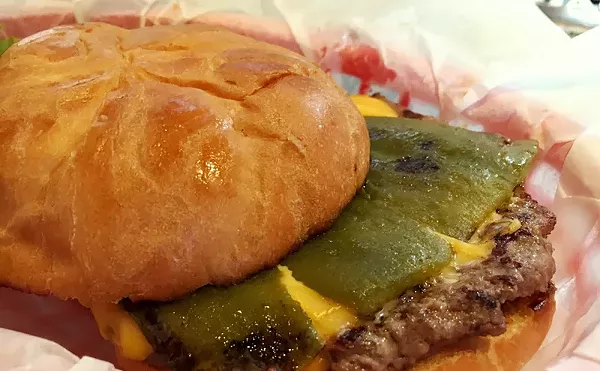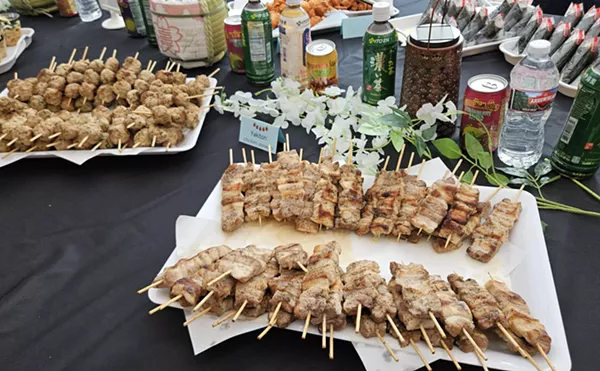And believe it or not, that's one of the things about Hapa that bugged me: not enough rules.
So where do we go when the Friday-night scene and the fusion menu and the funny names grow tiresome? We go to Sushi Tazu, around the corner and down the block at 300 Fillmore Street. And what do we order there? Everything. Because Sushi Tazu understands and respects the rules.
I know. If you've been reading this column for any length of time, you're right to think that I'm the last guy on earth who should be preaching the gospel of strict adherence to anything, but in the case of sushi -- actually, in the case of a lot of things culinary -- I am a bitter classicist at heart. In the stainless-steel world where I made my bones -- struggling as a young prep cook, pantry cook, saucier and commis -- there was one way to do a thing right and a million ways to get your ass kicked by the chef. Consommé? One way, the method described by Escoffier -- no cheating, no shortcuts, no screwing around. Demi-glace? One way, no arguments. Bordelaise? Okay, every chef had his own way of making this, and each was a little different, but in his kitchen, each chef's way was law, and woe to the poor saucier who accidentally substituted the methods of his last boss for the technique of his current master. In a lot of the kitchens I came up through, there was the feeling -- mostly unspoken, but no less real -- that if a cook made a dish a hundred times, he probably had a pretty good handle on how it was done, but he didn't really understand it until he made the dish a thousand times. Add in the screaming, the curses and the occasional thrown sauté pan, and you've got the Zen of the kitchen, French style.
But when you're a sushi chef, the idea of rules takes on a whole other dimension. For the apprentice, there are rules of preparation, rules of plating, rules that govern what can and can't be combined with what; more rules covering temperature and season, still more dealing with the shapes of plates, the number of pieces of sushi on the plate and, sometimes, the number of grains of rice in each piece and which direction each grain must face. A sushi chef training in the classical Edo style may spend two years doing nothing but making rice, mashing rice, rolling rice balls, dedicating his every waking moment to rice.
And after rice, there's nori -- the seaweed wrap of maki rolls. The sushi apprentice will give that another year of his undivided attention, maybe two. Then there's the knife (or knives, really -- twelve at a bare minimum), and he can expect to spend a decade honing those skills (no pun intended). Half of that time, the trainee will be cutting garnishes, shaving ginger, chopping scallions and cucumber -- the grunt work of the sushi line. At some point he'll be given mackerel, jack and octopus to play with, then salmon, then the cheaper cuts of tuna. The classically trained sushi chef, like the classically trained pianist or dancer, will devote half of his career -- the half when he is most energetic, most vigorous and most wild -- to acquiring an understanding of the rules, and the other half to seeing how brilliant, creative and original he can be within the boundaries of his training. He will spend half his life learning the basics and the other half learning how to do the basics better. You've got to admire that kind of dedication.
And I do. I love watching sushi chefs work, and while there aren't too many around these parts who've put in that kind of time learning their trade, I'm still amazed by any guy who can take rice, seaweed and raw fish and turn it into something as simple, lovely and sublime as a perfect tuna roll.
On top of all these rules for making the sushi, there's a different set of rules for eating the sushi, and I love these, too. I'm the guy who bitches about having to put on a jacket for dinner, still slurps his soup and has a devil of a time keeping his cuffs out of the gelato, but sit me down at a sushi bar, and all of a sudden I'm the soul of restraint and decorum. It's not that I don't want to embarrass myself -- trust me, I've embarrassed myself all over this town -- but that I like the rules. They make sense to me. And my obeying them is a measure of the respect I have for the kitchen.
At Tazu, I always lay my chopsticks parallel to the edge of the bar, with their tips balanced on the rim of the little soy sauce dish set at every place. I don't pass food with my chopsticks, but rather offer the plate -- and if I'm offered a plate, I take a morsel with the blunt end of my sticks so that I don't get my cooties on anyone else's squid balls. I know that in somewhat-ancient Japan, soy sauce was a rare and precious commodity -- not the sort of thing you could pick up by the ten-gallon can at your nearby grocery store -- so I understand that even today, I am not to fill the dish all the way, but to pour only as much as I think I will need.
I try not to drop rice in the soy sauce, because doing so would mark me as a boob and a miscreant, clumsy with my chopsticks and unfit for polite company. And if somehow I do get rice in the soy sauce -- or fumble a piece of nigiri while trying to turn it fish-side down into the proper dipping alignment -- I realize it would be impolite to leap up from my seat and harangue the staff about how their culture managed to invent paper, gunpowder, the abacus and Pokémon, but couldn't come up with the fork.
I know to order all I can eat and to eat everything I order. I understand that leaving anything behind -- even one grain of rice -- can be considered an insult. I also recognize that it's rude to stick pieces of sushi in your pockets, even if you accidentally ordered the smelt roe with cucumber and would rather eat one of your own toes than try one more bite.
Above all, I know not to put wasabe in the soy sauce, because doing so is the equivalent of asking for A-1 sauce to go with your $60 prime aged filet mignon. It insults the chef -- and at Tazu, the chefs are good enough that they always deserve the benefit of the doubt. When your order arrives, try a piece. If you then decide it needs a little kick, add some wasabe to the side of the piece that won't be touching the soy -- preferably at the end that will touch the tip of your tongue so you don't fry out your sinuses if you use too much -- and then eat. One piece, one bite: Don't bite it in half and then return the remainder to your plate. And that pickled ginger? It doesn't go with the sushi, but before it, after it or between courses. It's meant as a palate cleanser, not a condiment.
Yes, the rules matter at Tazu. The sake here is warm and served in wooden boxes. The green tea is a deep and smoky jade. Any discrepancy between one plate of salmon maki and the next would have to be measured with a micrometer. And while Tazu does offer a few modern interpretations -- crispy crab rolls stuffed with soft-shell meat and red leaf lettuce in a seared, inside-out maki striped with sweet teriyaki and something that tastes like Russian dressing; tempura shrimp and avocado; bonito sashimi with a sweetly bitter ponzu sauce -- they're something extra, sharing space on the menu with classic natto (fermented soy bean and quail egg, roughly the consistency of snot but not quite as tasty), ama ebi nigiri (raw-shrimp hand rolls, as delicious as they are creepy to eat) and tuna rolls, but segregated from the traditional fare spiritually if not physically.
At Tazu last week, I ate tamago -- a thick slab of egg, fried like an omelette but served cold and bound to its rice ball with a single ribbon of nori -- that was slightly sweet, almost like a dessert. I tried the tobiko: a whole bunch of little eggs from a flying fish that were fresh, chilled and briny but served with cucumber -- which I did not like, rules or no rules.
I also ordered uni -- sea urchin -- which was something I wouldn't have eaten at Hapa on a bet. The best sea urchin I've ever had was at Opal -- Duy Pham's now-infamous Sea Urchin, Three Ways -- and after that, I swore I would never eat sea urchin anywhere else. But Pham's no longer Opal's chef, so sea urchin is again fair game -- and Tazu's was pretty good. A mound of shaved, bright-orange (which signified middle quality -- between yellow, the cheapest, and red, the best) urchin genitalia came stacked on rice in a loose nori wrapper. The texture was like foie gras -- fatty, slick and rich -- and the taste incomparable to anything except maybe lobster tomalley, with less grit and more raw, sea-green punch (which makes sense, because urchins are what lobsters eat). At Opal, Pham messed with the meat: He fried it, whipped it, scorched it like a brûlée. But Tazu served pure sea urchin -- in particular, its hermaphroditic reproductive machinery -- and nothing more.
And finally, I got to Tazu's o-toro, two little slivers of the prized, fatty and ungodly expensive tuna belly that's one of the finest delicacies in the sea. I trusted Tazu to do right (and erase the memory of Hapa's brown toro), and the kitchen didn't let me down. The o-toro was beautiful -- ripe and fresh, gleaming, luminescent rosy pink with spidery veins of fat, neither tinny from rigor and a harsh death nor heavy with blood from being belly-down on the dock too long. The flavor was tuna to the tenth power, the texture like melting silk. And the rice ball the o-toro sat on lent nothing but its bulk and a feeling of cool weight to a taste that would never need help from anything. Centuries of knowing rice, of knowing the knife, of catching and butchering and isolating the best bits of the best tuna, of understanding the rules and obeying tradition, all came down to this. One bite. No soy. No wasabe. Ginger before, warm sake after, and in between, bliss.
Sushi Tazu is where you go when you outgrow the Orgasm roll and crabmeat with cream cheese, when the lure of weird and flashy is overtaken by the need for perfect bites. It's where you go to find out the rules and taste why they matter. It's where you go when you've learned to taste the difference between the cook's hundredth dish and his thousandth.
Leftovers: The dreaded Cafe curse hit two weeks after I awarded Opal the prize for best new restaurant in the Best of Denver 2003. Chef Duy Pham (who'd cooked that great sea urchin) left, moving on to Flow (which he subsequently fled) -- and Opal has never been as good since. The curse struck again after I raved about Bistro Adde Brewster, which was sold while the presses were still warm, transformed into Bistro 250, then closed and sold again. Today that space at 250 Steele Street is Agave Underground.
And Griff's Burger Bar caught fire and burned the very day my review of the South Broadway institution hit the streets.
Twice, it's a coincidence. Three times, it's a trend. And four? The curse is getting downright weird. Late last week I heard from Amy DeWitt, whose Cream Puffery I'd reviewed in the November 6 issue. She told me that everyone there was "so happy to hear I'd liked everything except the rum balls," but that they weren't able to take advantage of the good press because that morning they'd had to toss out every bit of pastry, every cake, every cookie and all the supplies in the place. The night before, tenants moving into the space next door to the Puff -- "lovely people," DeWitt insisted, and friends of the Puff's crew -- had been putting some kind of toxic sealer on their floor, and the fumes (as fumes are wont to do) seeped through the walls, under the doors and straight into the Puff's bakery cases.
"We had to throw away everything," DeWitt said. "Thousands of dollars in inventory, all of our pies and desserts, wedding cakes. We came in in the morning and everything tasted like kerosene."
By the time I spoke to DeWitt on Thursday afternoon, they were getting by on two or three cakes fresh out of the oven and scrambling to make more. Insurance should cover most of their losses -- but it's not going to do anything to take away the Cafe curse.
While Aquarela got the hook shortly after I reviewed them, the space at 3000 East Third Avenue is now going to a greater good. It's been picked up by Charley Master --the floor manager at Mel's Restaurant and Bar and the son of Mel and Jane Master -- who will open Brix (the name refers to a measurement of the sugar in a grape before it gets squished into wine) in mid-January. He says it will be an "eclectic" spot, featuring thirty wines under thirty bucks, house-made gourmet potato chips, Ella Fitzgerald and the Rolling Stones on the sound system, and a borderless menu meant to reflect the best of anything, from anywhere. Master envisions the place as a spot for off-duty cooks to grab a quick, interesting dinner; as a comfy space for local foodies to relax; and as an ideal destination for folks who don't want to drive all the way downtown for dinner, then back home again with a headful of wine.
"There's only a couple of places in town now to go to be cheap and cheerful," says Master. "And this is going to be one of them."
I promise not to set foot inside until I've shaken this whammy.
The Capital Grille, the latest addition to Larimer Square's rejuvenated restaurant lineup, opened Monday after a $4.5 million buildout, months of anticipation and a training program for the staff that rivaled Marine Corps boot camp. Dig this: three test lunches, five test dinners and a benefit event for National Jewish Hospital that brought in about twenty grand in donations; wine-tasting seminars for the floor staff, spirits classes for the bar, and even instruction for the valets in how to properly greet patrons. The new chef -- a local boy by the name of Paul Schutt, whom you might remember from his time at Jax -- spent three months training at another Capital Grille before he was allowed in the kitchen he'd been hired to run. General manager Charlie Stauter (ex of Denver's Palomino) did a similar out-of-town stint. And all this before the test dinners started.
That's a commitment to service that's becoming increasingly rare in the restaurant world, and all of that training, along with dry-aged steaks, a well-stocked bar, complimentary lunch and dinner valet parking, a 400-bottle wine list running from $20 to $500 a cork, and a menu that balances 24-ounce porterhouses against delicate steak tartare, just may help the Capital Grille stand out in Denver's crowded steakhouse scene.












